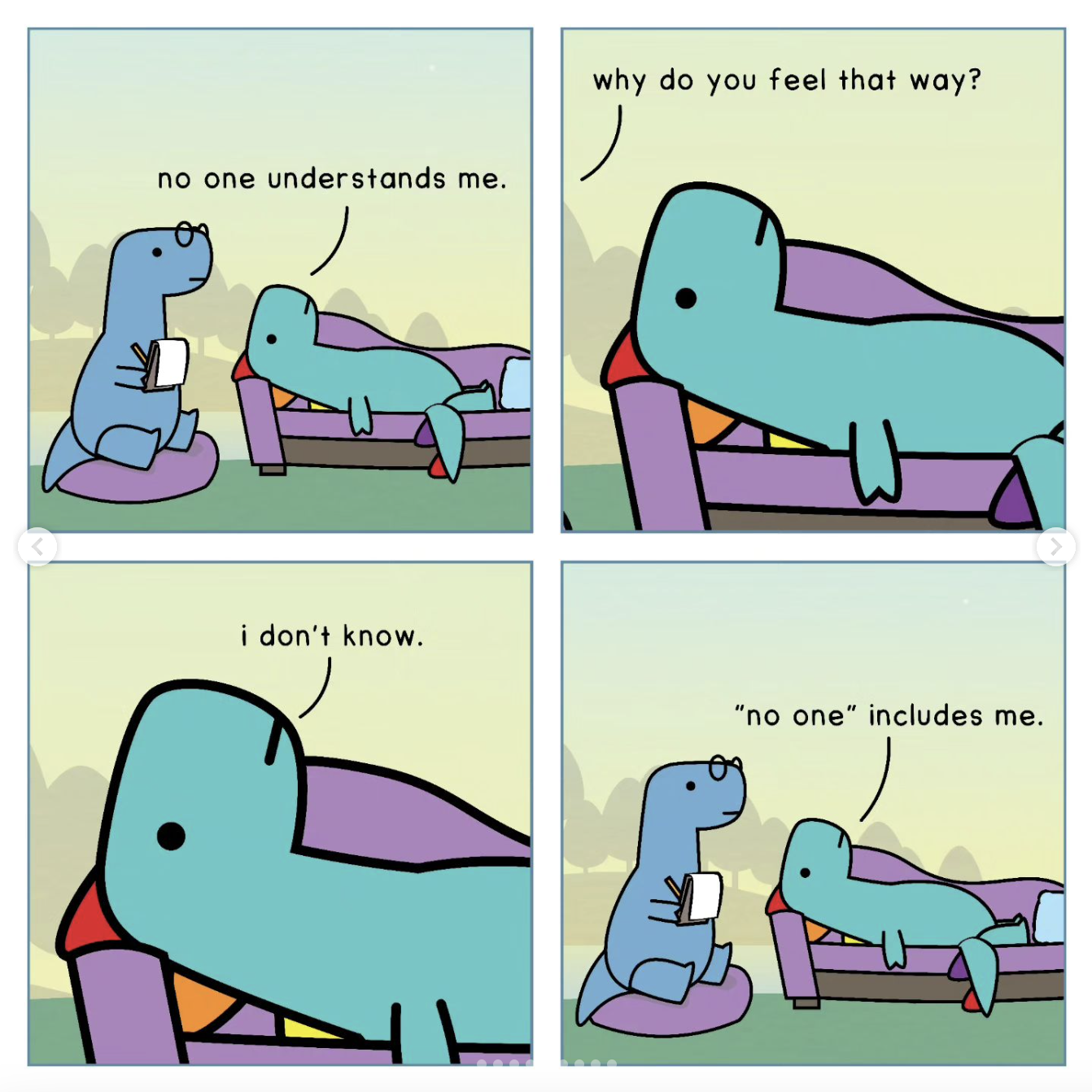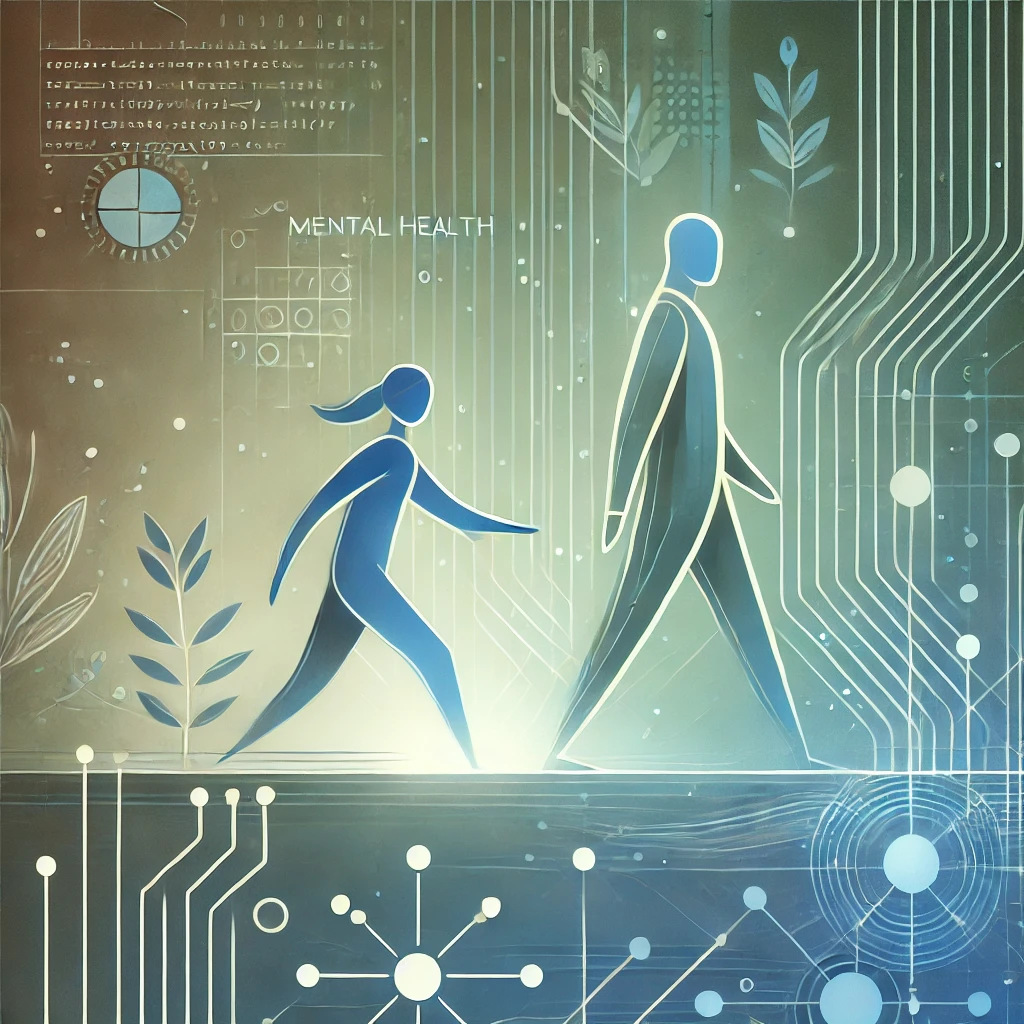Finding a good therapist is like dating. Sometimes you find exactly who you are looking for on the first go around, but not usually. Typically, you try many therapists for multiple sessions before finding one that you can see yourself spending a lot of time with. Someone who helps in ways you want to be helped. For me, I wanted to be supported and challenged at the same time.

After many therapists, I finally found one who was able to stimulate my intellectual brain while talking through my depression and anxiety. It was awesome! You’ve heard me talk about him in a previous blog. Other therapists encouraged me to talk about my childhood and use coping strategies like meditation, but I always felt like I was missing something.
This was it. The intellectual component. The parallels. The view of my mental health as a system. The aerial view of how pieces are fitting together, how this impacts that. It sounded a lot like what I do at work. This is what sparked the idea to apply models I use in cyber security to depression. Let’s see what happens! And cross fingers and toes I don’t set the mental health field back a decade 😅
Cybersecurity uses threat modeling to identify potential risks, vulnerabilities, and attack vectors within complex systems. This proactive approach allows fortification of defenses and safeguard against potential breaches or cyber-attacks. But what if we could apply this same concept of threat modeling to mental health, specifically focusing on the enigmatic and often debilitating condition some of us know all too well?

In this blog, I conceptualize depression as a system, akin to a digital infrastructure susceptible to threats. We’ll explore the various components and stakeholders involved in the “depression system” and analyze how these factors contribute to the overall experience of depression. By identifying the threats that surround depression, we aim to shed light on the complexities of this condition and advocate for a more comprehensive and empathetic understanding of mental health.
The purpose of this blog is not to trivialize the profound struggles individuals face due to depression but rather to explore a perspective that might aid in reducing stigma and enhancing support systems. By drawing parallels to cybersecurity’s threat modeling, I hope to provide a new framework for discussing depression, one that promotes awareness, compassion, and proactive mental health care.
Understanding the System (Depression)
If you want something more clinical here, feel free to go look up the definition of depression on many credible sites.
For me, depression looks like insomnia until 2am and then being glued to my bed in the morning. Wanting nothing to do with the things I know are good for me.
It’s clothes piled up in my closet, and “when did I shower last?” and “where are all my socks?”.
It looks like canceled plans, sending you to voicemail, and unanswered text messages. And from time to time, walking around the house completely unaware of my surroundings.
Depression is the human suit I put on when I need to see people who I don’t want to bother with yet another depressive episode.
Depression is a time stealer and a liar.
Applying a threat model to it won’t change how intensely I feel it. My only hope is it helps us find a little compassion for ourselves when the days get really hard.
A. Defining Depression and Its Impact on Mental Health
While everyone experiences occasional sadness, depression surpasses typical emotional fluctuations, becoming a persistent and pervasive state that can significantly impair daily functioning. How many of you just did one of these? 👇

Some symptoms can include:
- Loss of interest or pleasure in activities once enjoyed
- Changes in appetite — weight loss or gain unrelated to dieting
- Trouble sleeping or sleeping too much
- Loss of energy or increased fatigue
- Increase in purposeless physical activity (e.g., inability to sit still, pacing, handwringing) or slowed movements or speech
- Feeling worthless or guilty
- Difficulty thinking, concentrating or making decisions
- Thoughts of death or suicide
The impact of depression on mental health is profound, affecting cognition, emotions, and behavior. It can lead to cognitive impairments, such as difficulties in concentration and decision-making, making even the simplest tasks feel overwhelming.
Emotionally, depression can elicit a sense of emptiness, worthlessness, and increased irritability, straining personal relationships and social interactions.
Moreover, it might manifest in physical symptoms like changes in appetite, sleep disturbances, and even contribute to chronic health conditions.
B. Identifying the Components and Stakeholders Involved in the “Depression System”
These are the four buckets most things fall under. We’ll deep dive into them and get some examples later, but for now. It’s just good to know what these mean.
- Biological Components: Understanding the role of neurotransmitters, brain structure, and genetic predispositions.
- Psychological Components: Recognizing cognitive distortions, negative thought patterns, and maladaptive coping mechanisms that contribute to depression. I know I’m the one writing this, but feeling really called out on this one.
- Social Components: Assessing the impact of social support, relationships, and social isolation on depression.
- Environmental Components: Analyzing how life events, socioeconomic status, and cultural factors influence the development and course of depression.
Identifying Threats
In infosec, we identify threats to figure out how to protect against them. They’re usually threat actors or events with malicious intent. Sometimes depression seems like its out to get me. So let’s figure out what threats look like for depression.
Threats can be understood as internal, external, and cognitive factors that pose risks to mental well-being.
A. Internal Threats
- Biological Imbalances: Neurotransmitter imbalances, such as reduced serotonin levels, are often associated with depression. These chemical imbalances can influence mood regulation, leading to persistent feelings of sadness and despair.
- Genetic Predisposition: Family history and genetics can play a significant role in susceptibility to depression. People with a family history of depression may have an increased risk of developing the condition themselves.
- Cognitive Distortions: Negative thought patterns and cognitive distortions, such as catastrophizing or overgeneralization, can contribute to the perpetuation of depressive symptoms. These cognitive distortions often lead individuals to interpret experiences in a negative light, exacerbating their emotional distress.
B. External Threats
- Stressful Life Events: Traumatic experiences, major life changes, or chronic stressors can trigger or exacerbate depression. The loss of a loved one, financial difficulties, or significant career changes are some examples.
- Social Isolation: A lack of social support and feelings of social isolation can be detrimental to mental health. Individuals experiencing depression might withdraw from social interactions, further deepening their sense of loneliness and exacerbating their symptoms.
- Stigmatization and Lack of Understanding: Societal stigma surrounding mental health issues can prevent people from seeking help and support. The lack of understanding and empathy towards depression can make it challenging to open up about struggles and seek help.
C. Cognitive Threats
- Hopelessness and Helplessness: A pervasive sense of hopelessness and helplessness can contribute to the severity of depression. Feeling that things will never improve or a lack of control over circumstances.
- Self-Criticism: Excessive self-criticism and a negative self-image can fuel feelings of inadequacy and low self-worth, intensifying the emotional burden of depression.
- Rumination: Constantly dwelling on negative thoughts and past experiences can intensify depressive symptoms and prevent individuals from moving forward.
I feel like it’s important to say that sometimes your threat model might be a little light on information here. Maybe you don’t have a history of trauma or a specific life event that you can point to. Maybe it doesn’t run in your family and you aren’t sure why you are struggling.
If that’s you, it’s ok. You’re not alone. The whole of mental and behavioral health sciences are still trying to figure this shit out. If you don’t have it all figured out, welcome to the party where we’re all just doing our best.

Vulnerabilities and Risk Factors
Let’s take malware as an example. It’s a common thing to threat model for, especially with the rise of ransomware. A risk factor for them might be an out of date OS or EDR.
In our threat model for depression, vulnerabilities represent individual characteristics or predispositions that make some people more susceptible to experiencing depression.
Risk factors, on the other hand, are external influences that increase the likelihood of depression onset or exacerbation.
By understanding these vulnerabilities and risk factors, we can better identify those at higher risk and implement preventive measures to promote mental well-being.
A. Vulnerabilities
- Genetic Vulnerability: Although genetics don’t determine one’s destiny, they can play a role in shaping susceptibility.
- Personality Traits: Certain personality traits can create vulnerabilities to depression. For example, a tendency to be overly self-critical, perfectionistic, or highly sensitive.
- Early-Life Experiences: Adverse childhood experiences, such as abuse, neglect, or trauma, can have long-lasting effects on mental health and may increase the vulnerability to depression later in life.
B. Risk Factors
- Chronic Stress: Persistent exposure to high levels of stress, whether related to work, relationships, or other life challenges, can elevate the risk of developing depression. Well if this doesn’t sum up the last 4 years for most of us.
- Lack of Social Support: Social support acts as a buffer against stress and emotional challenges. A lack of supportive relationships can heighten the risk of depression and hinder recovery.
- Substance Abuse: Substance abuse, including alcohol and drug use, can exacerbate depressive symptoms and increase the risk of developing depression, forming a dangerous cycle.
- Medical Conditions: Certain medical conditions, such as chronic illnesses, hormonal imbalances, or neurological disorders, can contribute to the development of depression.
- Life Transitions: Major life changes, like divorce, job loss, or relocation, can be significant stressors and increase the risk of experiencing depressive episodes.
Similarly to what I mentioned above, it is important to note that the presence of vulnerabilities or risk factors does not guarantee the development of depression, nor does their absence guarantee immunity. Depression is a complex condition influenced by a myriad of factors, and each individual’s experience is unique.
Impact Analysis
This is the point where, in security, we rank the vulnerabilities depending on how much damage they might do if exploited. Sensitive data that might be leaked, financial loss, etc.
Let’s face it, depression affects everything. It hurts everywhere and everyone around it. With this next phase of the threat model, we figure out the far reaching impact mental illness can have on our lives.
A. Emotional Impact
- Persistent Sadness: Overwhelming feelings of sadness and despair can make it difficult to experience joy or pleasure in everyday activities.
- Emotional Numbness: Some individuals with depression may experience emotional numbness, where they feel disconnected from their emotions, both positive and negative.
- Increased Irritability: Depression can lead to heightened irritability and decreased tolerance for frustration, which can strain personal relationships.
B. Cognitive Impact
- Impaired Concentration and Memory: Cognitive impairments can hinder concentration, attention, and memory, affecting work performance and academic achievements.
- Negative Thought Patterns: Depression often involves negative and self-critical thought patterns, leading to a distorted perception of oneself and the world.
- Difficulty Making Decisions: Individuals with depression may struggle to make even simple decisions, as feelings of hopelessness and indecisiveness prevail.
C. Physical Impact
- Sleep Disturbances: Insomnia or excessive sleeping patterns are common in depression, further impacting energy levels and overall physical health.
- Appetite Changes: Depression can lead to changes in appetite, resulting in weight gain or loss, which can have additional health implications.
- Chronic Health Conditions: The stress and physiological changes associated with depression can exacerbate existing medical conditions or increase vulnerability to new health issues.
D. Social Impact
- Social Withdrawal: Individuals with depression may withdraw from social interactions, leading to isolation and loneliness, further exacerbating their emotional distress.
- Strained Relationships: Depression can strain personal relationships, as communication difficulties and emotional numbness may lead to misunderstandings and conflicts.
- Impact on Work/School Life: Depression can interfere with work productivity, school attendance, and performance, affecting professional and academic growth.
E. Impact on Other Mental Health Conditions
- Co-Occurring Disorders: Depression often coexists with other mental health conditions, such as anxiety disorders or substance use disorders, amplifying the overall impact on mental well-being.
- Suicidal Ideation: In severe cases, depression can lead to thoughts of self-harm or suicide, underscoring the critical importance of early intervention and mental health support.
It’s harder to rank the impact depression has on your life than it is to rank the impact malware has on your company’s system. It’s harder because its so nuanced and personal and sensitive and scary. But its imperative. Being willing to acknowledge how serious it is, increases our chances of getting the help we need and deserve.
Mitigation Strategies & Building Resilience
It was all building up to this. We have outlined threats, noticed our own vulnerabilities, risks factors, and predispositions and now we’re ready for the strategies that offer hope and support. Strategies that build our resilience.
For me, it’s been quite the journey to figure out what works and what doesn’t. I have some cheat codes that I talk about regularly. Lifting, not eating like an asshole, basic hygiene, practicing self compassion, and, a big one for me this last year, sobriety.
But there have been other things too. Ketamine saved my life. Finding a good therapist really changed my perspective on things. And I moved my office to a space that had more light. Better energy.
If you are curious about where to start. Here are some options.
A. Therapeutic Approaches
- Cognitive Behavioral Therapy (CBT): CBT is an evidence-based psychotherapy that helps individuals identify and modify negative thought patterns, replacing them with healthier and more constructive beliefs. It also focuses on behavioral changes to improve coping skills and emotional regulation.
- Mindfulness-Based Interventions: Mindfulness practices, such as meditation and yoga, can cultivate present-moment awareness, reduce rumination, and enhance emotional well-being.
- Acceptance and Commitment Therapy (ACT): ACT encourages individuals to accept difficult emotions and thoughts while committing to values-based actions that promote personal growth and well-being.
B. Medication and Professional Support
- Antidepressant Medication: In cases of moderate to severe depression, antidepressant medication prescribed by a qualified healthcare professional may be beneficial. These medications can help stabilize mood and alleviate symptoms.
- Psychiatric Care: For individuals with complex or treatment-resistant depression, psychiatric care can provide specialized assessment and treatment options.
C. Lifestyle Changes
- Physical Activity: Regular exercise has been shown to have a positive impact on mood and overall well-being. Engaging in physical activity can increase endorphins and reduce stress.
- Nutrition: A balanced and nutritious diet can influence brain function and positively affect mood. Incorporating foods rich in omega-3 fatty acids, antioxidants, and B vitamins may be beneficial.
- Sleep Hygiene: Establishing a consistent sleep routine and creating a conducive sleep environment can improve the quality of sleep, helping to alleviate depressive symptoms.
D. Early Intervention and Support Systems
- Mental Health Awareness Programs: Promoting mental health awareness and reducing stigma can encourage early intervention and create an environment where individuals feel safe seeking help.
- Peer Support Groups: Joining support groups or seeking peer support can offer a sense of community and understanding, reducing feelings of isolation.
- Enhancing Social Support: Strengthening social connections and communication with friends, family, or support networks can provide emotional support during difficult times.
Everyone is going to need a different mitigation cocktail. What works for me won’t necessarily be the best solution for the next person. The best approach is to start trying different things. See what sticks.
While I want to encourage people to befriend experimentation, the truth is trying can be hard. Depression makes everything hard. So my best advice is to put things in place on a good day. Doing things on the hard days is just not realistic.
Call your friends and family and tell them what to look for, what to do if they notice you spiraling, and then ask them to give you what you need.
Buy groceries on a good day. Do the cook up.
Join the group. Schedule the appointment. Set the screen time limits.
Or whatever combination of things you think might work for you.





